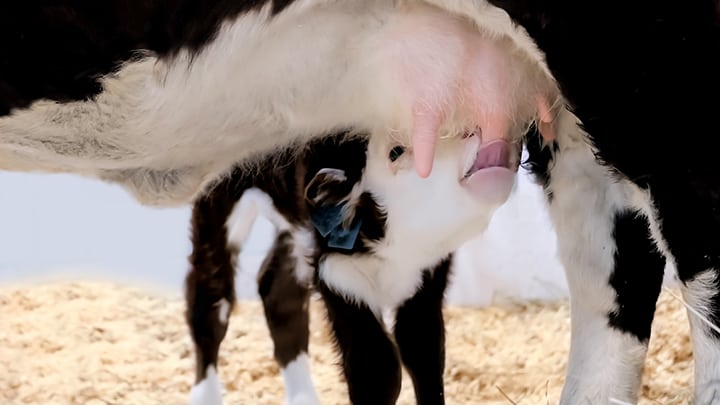We are aware of the importance of that first milking colostrum in providing immune globulins (Ig) or antibodies as a source of protection from disease for the newborn calf. Feeding four quarts of clean colostrum with a low bacteria count as soon as possible after birth is the key to success. However, have we missed other benefits from feeding colostrum and the “transition” milk from the first to sixth milkings to calves during their first few days of life? Read more …
Colostrum is more than IgG. What have we been missing?

We are aware of the importance of that first milking colostrum in providing immune globulins (Ig) or antibodies as a source of protection from disease for the newborn calf. Feeding four quarts of clean colostrum with a low bacteria count as soon as possible after birth is the key to success. However, have we missed other benefits from feeding colostrum and the “transition” milk from the first to sixth milkings to calves during their first few days of life?
Let us compare dairy calves and beef calves.
Compare how we manage the newborn and preweaned dairy calves as compared to beef calves. Beef calves suckle mom, consume multiple meals during the first day of life and continue to exhibit this nursing behavior until being weaned at a much later age. Have we “compromised” the health and growth potential of dairy calves by how we manage them during the first week of life? Granted, the way we manage dairy calves, under good management, assures that they receive a large colostrum meal with high levels of Ig at a known age. However, are there other benefits of colostrum and transition milk that we may be missing?
Colostrum contains various bioactive constituents.
First, there are benefits in feeding mom’s colostrum to her calf. Owing to the unique anatomy and physiology of the newborn calf, they can absorb the Ig and immune cells from the dam. These immune or “white blood” cells function by stimulating development of the immune system in the calf at a much earlier age. Unfortunately, this benefit requires consumption of the dam’s fresh colostrum.
Colostrum also contains higher levels of various bioactive constituents which gradually decline reaching lower levels found in milk by the sixth milking. These include oligosaccharides, certain fatty acids, lactoferrin, growth factors (IGF, TGF..), enzymes, microRNAs, and cytokines. It is known that these colostrum constituents have a positive impact on cellular function, growth, and development when fed to calves during the first days of life.
Researchers in Canada compared calves fed similar quantities of first milking pooled colostrum followed by colostrum, a mix of 50% colostrum and 50% whole milk and only whole milk between 12 and 72 hours of age. Maximum serum IgG levels were reached at 13h of age for the whole milk fed calves while IgG levels for the remaining treatments plateaued near 30 h of age indicating continued absorption of Ig. Similarly, the surface area of intestinal tissue for calves receiving colostrum or the mixture was more than 50% greater than calves receiving only whole milk. This likely indicates benefits not only for IgG absorption but also other nutrients which are so critical for the very young calf.
Earlier and longer is better.
Age at consumption of the first colostrum meal is also important. The height of the intestinal villi and depth of the crypts are reduced as age increases at the first colostrum meal. These measures indicate a reduction in absorptive surface area, which likely has a negative impact on absorptive efficiency at a critical time of the calf’s life. Delays in colostrum consumption are also associated with fewer beneficial bacteria and an increased prevalence of opportunistic pathogens in the intestinal biome. These findings illustrate the importance of not only early feeding of colostrum to calves, but also the potential value of prolonged feeding of colostrum or transition milk to calves.
Consequent management will raise your profit.
Unfortunately, many of today’s maternity and young calf management systems are not designed to implement these practices successfully in a consistent manner. Research and experiences of well managed calf programs continue to demonstrate the impact of more rigorous calf management programs on health, growth, and later productivity as cows. With the increased use of genomics and the practice of using sexed semen and raising fewer female calves there is potential for a greater net economic return from the feeding of the dam’s colostrum to her calf and to the feeding of “transition” milk to calves that are less than 72 h of age. Is it time to design systems and implement protocols which:
- allow feeding colostrum from the dam to her calf to realize the benefits of maternal cellular immunity? A successful response requires a high level of biosecurity and a negligible risk of disease organisms in colostrum or transition milk.
- enable harvest of second through sixth milkings, rapidly cooling it to minimize microbial growth and storing it in sanitary containers until fed with the priority given to the calves less than 72 h of age?
Recognize that in most cases, pasteurization is a recommended practice to reduce bacterial numbers and the risk of disease transfer to calves in both first and later milkings. Colostrum replacers are also viable alternatives which, although an added expense, can simplify colostrum management and deliver needed Ig and bioactive compounds efficiently and effectively. Early research trials also indicate potential benefits in adding limited amounts of colostrum replacer to the diets of calves during the first weeks of life.
The feeding of the dam’s colostrum and use of transition milk is a significant departure from the current systems on many larger dairy businesses. Success requires careful facility planning and a commitment of personnel at all levels to assure that there is a positive net economic benefit.
Bob James – Calf Blogger
